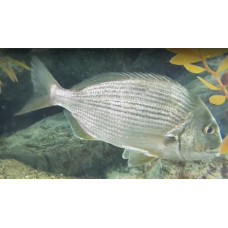Latin name
Rhabdosargus sarba
Other name
Silver bream, tarwhine, yellowfin bream.
Identification
The goldlined seabream has a deep and compressed body, with a depth of 2-2.3 times its standard length and a large head. The dorsal profile is convex, with the greatest curvature between the snout and the beginning of the dorsal fin. The medium-sized eyes are relatively small in adults. The largest molars are located at the rear of the third outer row.
Features of fish fins
The dorsal fin is supported by 11 spines and 12 or 13 soft rays, while the anal fin is supported by 3 spines and 11 soft rays.
Fish colouring
The overall coloration of this fish is grayish with a silvery-golden tinge, the ventral surface is silvery white and the sides have thin horizontal bands of yellowish to golden color. The ventral and anal fins are yellowish to brownish-yellow.
Distribution
Widespread in the Indo-Pacific region from the Red Sea and east coast of Africa to the southern coast of South Africa, eastward across the Indian and Pacific Oceans to the South China Sea and Japan, and southward into Australia. In Australia, it occurs along the west coast from Bremer Bay to Exmouth and along the east coast from Townsville, Queensland, south to Mallacoota, Victoria. There are isolated occurrences in the Mediterranean Sea off Syria, but it is most likely a migrant from the Red Sea via the Suez Canal.
Habitat
A marine, oceanodromous, tropical, reef-associated species. Depth range 0 to 60 m.
Size
The maximum published total length of this species is 80 cm, although 45 cm is more typical, and the maximum published weight is 12 kg.
Behavior
Juveniles are found in estuaries, while adults move to deeper coastal waters. They are often found in schools.
Food and feeding habits
Goldlined seabreams prey on benthic invertebrates, primarily mollusks.
Reproduction
The species has been found to be a protandrous hermaphrodite off South Africa, Hong Kong and the Persian Gulf, but recent studies off Western and Eastern Australia have shown it to be a rudimentary hermaphrodite in these waters. These reproductive differences may indicate that these different populations may be different species and that R. sarba represents a species complex. Off the coast of South Africa, sexual maturity is reached at a total length of 26 cm (10 in), while in Western Australia it is reached at a fork length of 15 to 21 cm (5.9 to 8.3 in). Spawning occurs between July and November off KwaZulu-Natal in coastal waters near large estuaries and mouths. Off the coast of Western Australia, golden perch also spawn between July and November, spawning in schools. The age at which half of the fish in KwaZulu-Natal reach sexual maturity is about 1.8 years, and they change sex from male to female between 1 and 2.5 years of age. Goldlined seabream have been observed moving into deeper coastal waters to spawn.
Fishing
Rahbdosargus sabra is an important species for recreational anglers in Australia, although it is of minor commercial importance in southwest Australia. In South Africa and Mozambique, the species is hunted by artisanal fishermen and is also an important target for recreational anglers.
Relationship with a person
Harmless. Sold fresh.
| Classification | |
| Phylum | Chordata |
| Class | Actinopterygii |
| Squad | Spariformes |
| Family | Sparidae |
| Genus | Rhabdosargus |
| Species | R. sarba |
| Features | |
| Conservation status | Least Concern |
| Habitat | Pelagic |
| Life span, years | No information |
| Maximum body weight, kg | 12 |
| Maximum length, cm | 80 |
| Sailing speed, m/s | No information |
| Threat to people | Edible |
| Way of eating | Planktonophage |
Goldlined seabream
Tags: goldlined seabream



